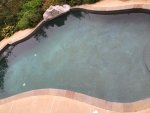Yes, the FAS-DPD portion of your Taylor kit (R-0870 powder and R-0871 drops) are the best to use. Test strips are useless. The OTO is simply a very quick "Total chlorine" check, and depending upon your required levels or experience using it, you may not get the best indications of low "free" chlorine. You can use regular liquid bleach (generic is fine) to help assist in raising your FC level a bit (perhaps to FC 9-10) just for a day or so, then check your CC level after that. You want your CC reading to be <=.5 ppm. When it's over .5, we start to get concerned the water needs help.
I didn't see anywhere on this thread your pool specifications (gallons), but if your pool size is 15K or less, then I suggest adding about 1/2 gallon of "regular" liquid bleach in the evening to assist with breaking-down the CC. If you have a pool over 15K, then make it one gallon. That, along with sweeping/scrubbing for a day should be good enough to see if your CC will lower on its own without having to do an OLCT or "SLAM".



 , but you're not finished yet until you pass an OCLT and CC are <=.5. Those are equally important. So keep that FC up at SLAM level, keep the pump circulating, and sweeping. A high CC means the algae is getting killed and in the transition stages of oxidation. That's your trash chlorine. In time we would hope that will get burnt-off and drop below .5.
, but you're not finished yet until you pass an OCLT and CC are <=.5. Those are equally important. So keep that FC up at SLAM level, keep the pump circulating, and sweeping. A high CC means the algae is getting killed and in the transition stages of oxidation. That's your trash chlorine. In time we would hope that will get burnt-off and drop below .5.